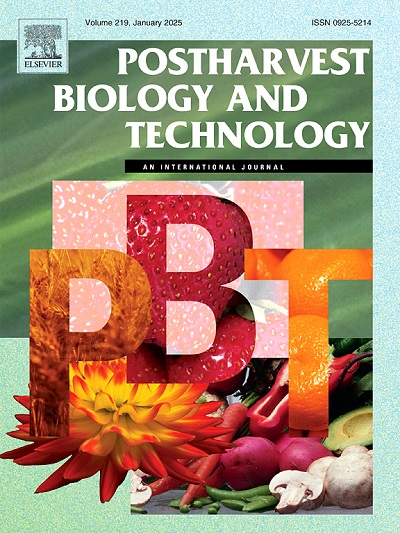代谢组学和转录组学研究揭示了采收香菇孢子释放诱导挥发性有机化合物的代谢机制
IF 6.8
1区 农林科学
Q1 AGRONOMY
引用次数: 0
摘要
香菇(Lentinula edodes)因其独特的香气而广受欢迎,这主要是由于它含有多种挥发性有机化合物(VOCs)。孢子排出是蘑菇的一个重要生理过程,对蘑菇的香气有重要影响。然而,孢子释放引起的香菇香气代谢及其机制尚不完全清楚。本研究利用电子鼻、色谱-质谱、代谢组学和转录组学等分析手段,探讨了采收的香菇孢子释放引发VOC代谢的机制。结果表明,孢子排放引发了VOC特征的变化。在63种挥发性有机化合物中,有23种被确定为潜在的挥发性生物标志物。八碳化合物和硫化物是主要挥发性有机化合物和关键挥发性生物标志物。代谢组学和转录组学分析表明,脂肪酸代谢、苯丙氨酸代谢和硫化物代谢是VOC积累的关键。这些结果为全面了解香薷采后香气调节网络提供了有价值的见解。本文章由计算机程序翻译,如有差异,请以英文原文为准。
Metabolomic and transcriptomic reveal the metabolic mechanism of spore discharge-induced volatile organic compounds in harvested Lentinula edodes
Lentinula edodes (L. edodes) is widely popular for its unique aroma, primarily due to its diverse volatile organic compounds (VOCs). Spore discharge is a vital physiological process in mushrooms that significantly influences their aroma. However, the aroma metabolism in L. edodes caused by spore discharge and its underlying mechanisms are not fully understood. This study utilized electronic nose, chromatography-mass spectrometry, metabolomics and transcriptomics analyses to investigate the mechanisms of VOC metabolism of harvested L. edodes triggered by spore discharge. Results showed that spore discharge triggered the changes of VOC characteristics. Among the 63 VOCs, 23 were identified as potential volatile biomarkers. Eight-carbon compounds and sulfides were the main VOCs and key volatile biomarkers. Metabolomics and transcriptomics analyses indicated that fatty acid metabolism, phenylalanine metabolism, and sulfides metabolism are key to VOC accumulation. These results provide valuable insights for comprehensive understanding of the aroma regulation networks of postharvest L. edodes.
求助全文
通过发布文献求助,成功后即可免费获取论文全文。
去求助
来源期刊

Postharvest Biology and Technology
农林科学-农艺学
CiteScore
12.00
自引率
11.40%
发文量
309
审稿时长
38 days
期刊介绍:
The journal is devoted exclusively to the publication of original papers, review articles and frontiers articles on biological and technological postharvest research. This includes the areas of postharvest storage, treatments and underpinning mechanisms, quality evaluation, packaging, handling and distribution of fresh horticultural crops including fruit, vegetables, flowers and nuts, but excluding grains, seeds and forages.
Papers reporting novel insights from fundamental and interdisciplinary research will be particularly encouraged. These disciplines include systems biology, bioinformatics, entomology, plant physiology, plant pathology, (bio)chemistry, engineering, modelling, and technologies for nondestructive testing.
Manuscripts on fresh food crops that will be further processed after postharvest storage, or on food processes beyond refrigeration, packaging and minimal processing will not be considered.
 求助内容:
求助内容: 应助结果提醒方式:
应助结果提醒方式:


